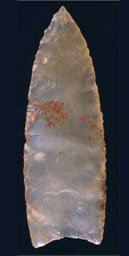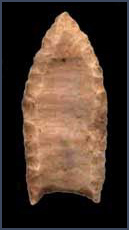Peoples of the Mesa Verde Region
The Paleoindian Period: 13,000 (or earlier) to 6000 B.C.Artifacts

Clovis points are often found with the bones of mammoth. Note the short, wide groove, or "flute," that extends a short way up the point from the base. Because the nomadic people of the Paleoindian period left only scattered traces of their existence—and because the Paleoindian period was such a long time ago—archaeologists find few artifacts that date from this era. But of the artifacts they do find, the most common are beautiful stone projectile points that would have been affixed to the ends of spears that hunters thrusted or threw by hand. 
Folsom points are often found with the bones of bison. On Folsom points, the "flute" extends almost the full length of the point. The two best-known styles of Paleoindian projectile points are called "Clovis" and "Folsom." Both have a wide, central groove, also called a "flute," which allowed them to be attached to the split end of wooden spear shafts. Clovis points, which were made early in the Paleoindian period, have been found throughout North America, most often associated with the bones of mammoths. Folsom points were made later, and they are found mostly in the central and western parts of the continent, often in association with the bones of bison. The raw materials used to make many of the Clovis and Folsom points were of exceptionally high quality. People traded or traveled great distances, sometimes up to 300 miles, to obtain the desired stone. And the workmanship on many specimens is outstanding—some archaeologists consider Folsom points in particular to be among the finest stone tools ever made. Of course, the people who lived during the Paleoindian period would have needed more than just stone tools to survive. But because artifacts made of less-durable materials, such as bone, animal hide, and plant fibers, rarely survive to the present, we know less about them. Fortunately, however, a few Paleoindian sites located in rock alcoves have yielded a number of artifacts that would not have been preserved in sites in less-protected locations. These rare perishable items, including moccasins, fiber sandals, fur robes, bags, baskets, and mats, provide additional clues to everyday life during the Paleoindian period. |
|
 DONATE TODAY
DONATE TODAY
